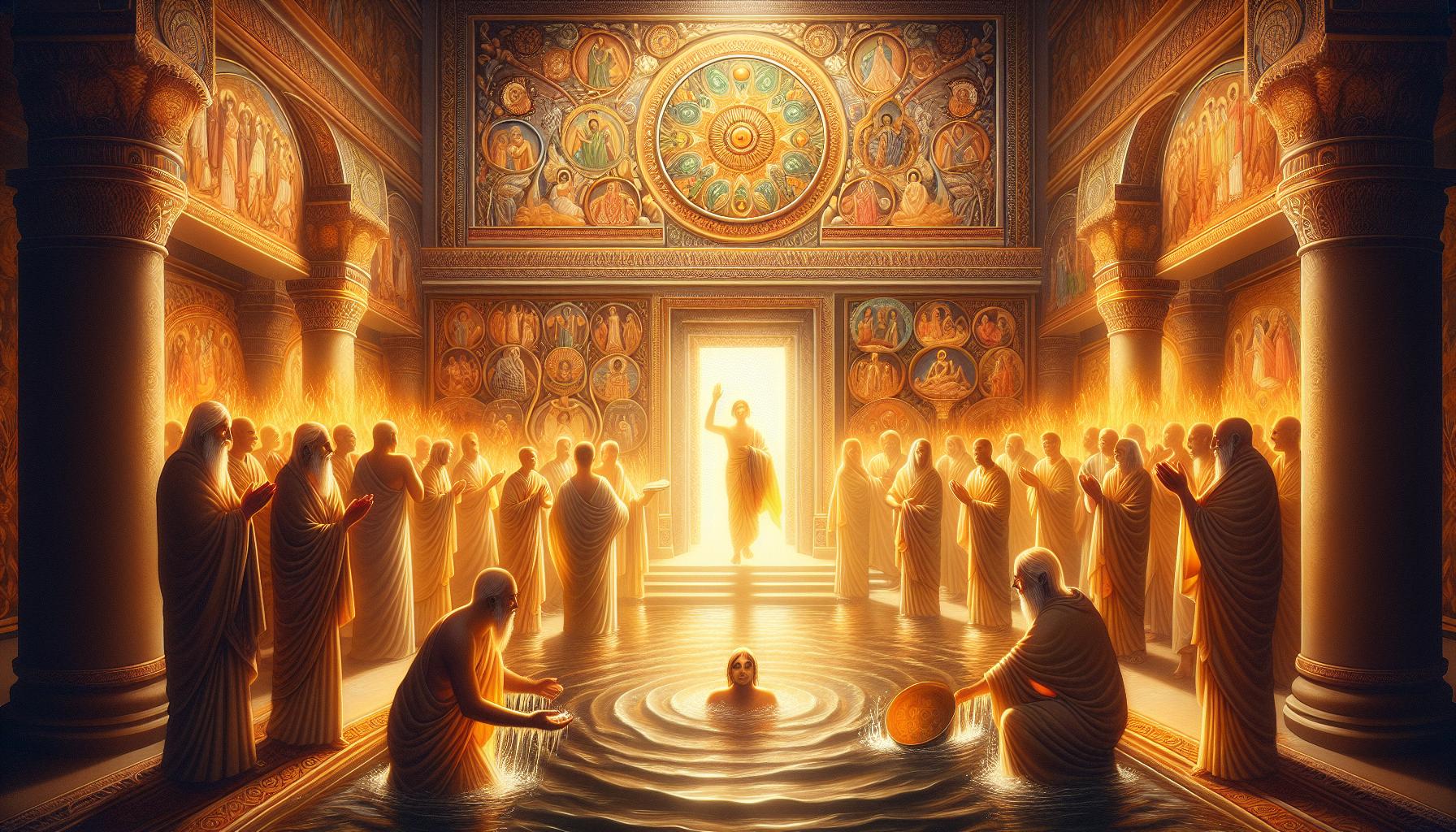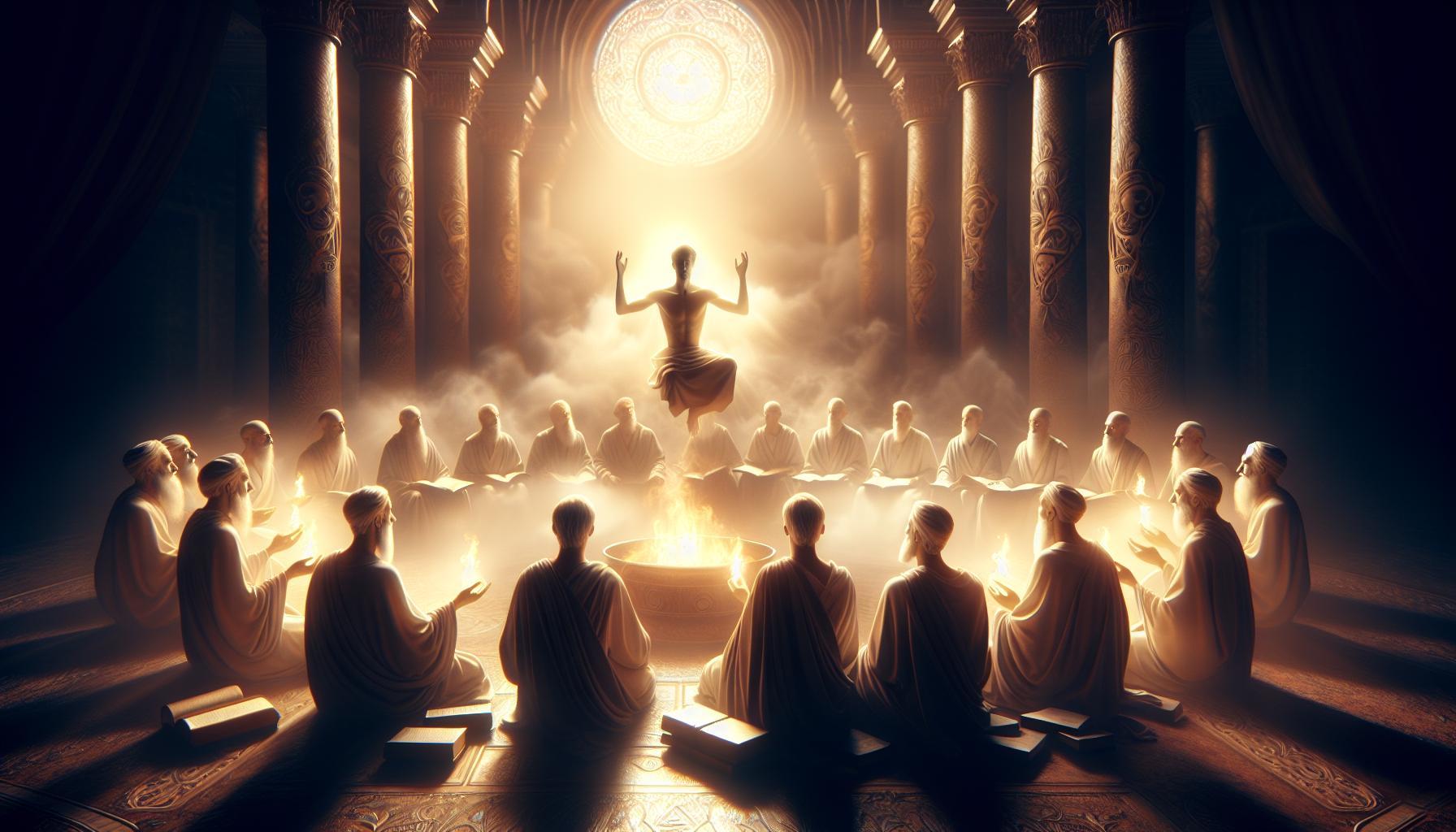The term “baptism of fire” evokes images of trial and transformation, often interpreted as a soldier’s first battle experience or as a metaphor for enduring life’s most challenging moments. Understanding this phrase is crucial for recognizing its significance in spiritual growth and resilience, offering insights into how adversity can refine our character and faith.
Understanding the Concept of Baptism of Fire: A Spiritual Awakening
The concept of a transformative experience often resonates throughout various spiritual traditions, and for many Christians, the idea of a baptism of fire symbolizes a profound spiritual awakening. This concept, deeply rooted in the New Testament—particularly through the words of John the Baptist in Matthew 3:11—suggests that fire serves both as a purifying force and as a means of empowerment. Understanding this baptism as a spiritual awakening involves recognizing its duality: it signifies both the purification of one’s soul and an initiation into a more profound relationship with the divine.
Symbolism of Purification and Empowerment
In Christian theology, fire often represents God’s presence and His ability to refine believers. The imagery aligns with the concept of refinement found in various biblical passages, which describe how God uses challenges and tribulations as tools for spiritual growth. This transformative process can be likened to the refining of gold, where the impurities are burned away, leaving behind a pure and valuable product. Such an experience not only cleanses the individual but also empowers them, equipping believers to fulfill their God-given purposes with clarity and strength.
- Purification: The baptism of fire initiates a cleansing process, allowing individuals to let go of past burdens and sins.
- Empowerment: The experience empowers believers, infusing them with courage and a renewed sense of purpose in their spiritual journey.
Modern Relevance of the Baptism of Fire
In today’s fast-paced world, many seek deeper meaning and direction for their lives. The baptism of fire can serve as a metaphor for personal struggles and challenges faced in contemporary society. It encourages individuals to embrace their trials as opportunities for growth and transformation. People are often called to step outside their comfort zones, facing fears and discomforts that ultimately lead to profound personal revelations and a more significant connection to their faith.
Real-life applications of this concept manifest in various ways, such as:
| Application | Description |
|---|---|
| Personal Challenges | Viewing difficulties in life as a ‘baptism of fire’ that prepares you for greater calling. |
| Community Support | Engaging with faith communities to share burdens and grow together spiritually, enhancing collective resilience. |
| Mentorship | Seeking or becoming a mentor to facilitate the journey of others experiencing their own spiritual awakenings. |
Embracing the baptism of fire as a spiritual awakening allows individuals to find strength in adversity and encourages a transformative faith journey that resonates with the essence of being renewed and empowered. Thus, it is not only a historical or biblically rooted concept but a relevant spiritual guide for those navigating the complexities of modern life.
Historical Context: The Origins of the Baptism of Fire in Religious Tradition
The concept of “baptism by fire” is steeped in rich historical and religious significance, intertwining experiences of trial and transformation. This phrase often denotes a challenging initiation, a rite of passage marked by extreme difficulty that ultimately leads to growth or enlightenment. One of its early associations lies within Christian doctrine, where it is frequently linked to the teachings of John the Baptist, who spoke of baptism as not only an act of purification but also as an entrance into a deeper spiritual reality.
Historically, “baptism by fire” finds its roots in biblical scriptures, particularly in the New Testament. In Matthew 3:11, John the Baptist conveys a powerful message, stating that while he baptizes with water, there will come one who will baptize with the Holy Spirit and fire. This duality emphasizes both purification and empowerment, suggesting that the trials which one undergoes serve as a means of spiritual cleansing and strengthening. Such transformative experiences resonate with the early Christian communities, who often faced persecution, thus contextualizing their suffering as a purifying fire leading them closer to their faith.
Over time, this phrase has been adapted to symbolize various forms of initiation across different cultures and contexts. For instance, in contemporary settings, it often refers to a newcomer facing the challenges of a new job, where the steep learning curve can feel akin to a battlefield—a daunting yet crucial experience for personal and professional development. This evolution of meaning emphasizes that experiences of distress or hardship can lead to resilience and newfound clarity, thereby making the “baptism by fire” a metaphor for growth through adversity.
In essence, understanding the historical context of “baptism by fire” offers valuable insight into its enduring relevance. It serves as a reminder that trials can be seen not merely as obstacles but as opportunities for transformation. Embracing such experiences can catalyze profound changes, aligning with the broader themes of renewal and rebirth that permeate religious traditions worldwide.
Common Myths: Debunking Misconceptions Surrounding Baptism of Fire
Understanding the nuances of spiritual experiences is essential for both seekers and believers. One common misconception about the “baptism of fire” is that it solely refers to a singular, dramatic event of spiritual awakening. In reality, this phrase often encapsulates a broader spectrum of experiences that involve purification and spiritual refinement. This misunderstanding can lead many to think that a baptism of fire must look like a miraculous or chaotic event, when it is actually more about ongoing growth and transformation in one’s faith journey.
Myths About the Baptism of Fire
- Myth 1: It Is Always a Chaotic or Traumatic Experience
While some may associate the baptism of fire with intense emotional upheaval, this interpretation overlooks the peace and clarity that can also accompany such experiences. Biblical references suggest that this process can lead to profound inner growth and sanctification rather than just chaos [[1](https://biblehub.com/q/what_does_’baptism_of_fire’_mean.htm)]. - Myth 2: It Only Occurs Once in a Lifetime
Another common misconception is the belief that baptism of fire is a one-time occurrence. In actuality, many believers experience this process multiple times throughout their faith journey as they face various trials and tribulations [[2](https://www.biblestudy.org/basicart/what-is-a-baptism-by-fire.html)]. - Myth 3: It’s Exclusively for the ‘Chosen’
Some think that only a select few believers can undergo this spiritual experience. However, the baptism of fire is available to all who seek a deeper relationship with God. It serves as an invitation to everyone willing to embrace God’s transformative power [[3](https://www.christianity.com/wiki/bible/what-does-baptism-of-fire-mean-for-christians-today.html)].
Understanding these myths is crucial for spiritual development. Rather than viewing the baptism of fire as something to fear or as a rare occurrence, it should be embraced as a natural part of one’s spiritual evolution. By recognizing that this process encompasses both trials and moments of tranquility, seekers can approach their faith journeys with a more open mind and heart. Emphasizing continuous growth through life’s challenges can inspire believers to explore their spirituality without the burden of misconceptions.
Theological Perspectives: Various Interpretations Across Denominations
The concept of the baptism of fire has stirred theological conversations across various Christian denominations, each offering distinct interpretations that reflect their theological framework and tradition. From Pentecostal exuberance to more reserved liturgical churches, the notion of being “baptized in fire” encapsulates a range of beliefs about spiritual empowerment, divine purification, and commitment to faith.
Distinct Doctrinal Views
Each denomination views the baptism of fire through its theological lens, shaping how believers experience and understand this powerful symbol. Here are some perspectives:
- Pentecostalism: Often synonymous with the experience of receiving the Holy Spirit, this tradition emphasizes the transformative power of fire as a means of empowerment for ministry and witness. Believers may interpret this baptism as an intense encounter with God’s holiness, leading to a passionate pursuit of spiritual gifts.
- Roman Catholicism: In Catholic theology, the baptism of fire can be linked to the sacrament of Confirmation, wherein individuals receive the Holy Spirit to strengthen their faith. Fire symbolizes the purgative aspect, representing the cleansing of sins and the call to live a life committed to Christ.
- Orthodox Christianity: Here, the baptism of fire is understood as a process of theosis, where believers are invited into a transformative relationship with God. Fire reflects God’s presence and essence, purifying the soul and illuminating the path to holiness and unity with the divine.
- Reformed Tradition: Within many Reformed circles, the baptism of fire may be seen allegorically, representing trials and tribulations that refine a believer’s faith. This interpretation emphasizes reliance on God’s grace amid life’s struggles rather than a mystical experience.
Modern Applications and Relevance
In contemporary faith practices, the baptism of fire has notable implications, affecting how various congregations engage with their communities and present the gospel message. Here are some ways this concept is finding modern relevance:
| Application | Description |
|---|---|
| Empowerment for Service | Many churches encourage members to seek the baptism of fire as a source of courage and boldness in outreach efforts, believing it energizes their mission work. |
| Renewal of Spirituality | Regular teachings on the baptism of fire serve as a call for believers to reassess their spiritual fervor, spurring initiatives aimed at spiritual retreats and renewal services. |
| Community Resilience | In times of crisis, faith communities interpret fire as a metaphor for resilience, encouraging support and growth through collective trials. |
Such diverse theological perspectives on the baptism of fire not only enrich the understanding of this powerful concept but also facilitate a broader dialogue among Christians. As believers navigate their faith journeys, recognizing these interpretations can foster deeper conversations and community engagement, making the question of what the baptism of fire truly signifies all the more relevant today.
The Role of Baptism of Fire in Personal Faith Journeys
The concept of baptism of fire can be a transformative element in an individual’s faith journey, often marked by intense trials and challenges that lead to deeper spiritual growth. This metaphor, rooted in scripture, serves as both a warning and encouragement, emphasizing the refining process believers undergo as they seek to align with their faith. In various biblical passages, such as those presented by John the Baptist, it is portrayed as a way to purify character and underscore the gravity of one’s spiritual commitment.
In personal faith journeys, the baptism of fire can manifest through life’s challenges that seem overwhelming at first. These trials often serve a dual purpose: they test one’s faith and offer opportunities for sanctification. For example:
- Loss and Grief: Experiencing the death of a loved one can evoke profound sorrow, yet it may also deepen one’s reliance on faith, fostering comfort and hope in promises of eternal life.
- Health Struggles: Battling illness can lead to a stronger pursuit of spiritual understanding, as individuals often discover resilience and community support they might not have sought otherwise.
- Financial Hardship: Facing economic instability may encourage a believer to reflect on materialism and prioritize spiritual wealth, leading to a re-evaluation of life’s true purpose.
The notion of a baptism of fire as a purifying process offers a broader understanding of adversity within a faith context. It invites individuals to view their suffering not merely as punishment but as part of a divine plan for personal growth and deeper connection to God. This understanding aligns with the perspective that trials, while challenging, can lead to the removal of spiritual impurities, fostering a more profound relationship with the divine.
Ultimately, embracing the baptism of fire within one’s faith criteria equips believers with the tools to navigate their spiritual journey with courage and hope. As they encounter and overcome challenges, they often emerge transformed—strengthened in their faith and equipped to support others facing similar trials. This journey not only enriches personal belief but also amplifies the communal aspect of faith, where shared experiences of hardship can lead to collective healing and encouragement.
Practical Implications: How Baptism of Fire Shapes Modern Spiritual Practices
Experiencing a “baptism of fire” can become a transformative event in the journey of modern spiritual seekers, infusing their practices with a sense of urgency and deep personal growth. This concept, which often refers to intense challenges or trials that lead to spiritual awakening, shapes contemporary rituals and life philosophies across various faiths and traditions. The profound implications of undergoing such ordeals can motivate individuals to harness their inner strength, embrace vulnerability, and deepen their compassion for others.
In practical terms, the concept of baptism by fire is integrated into spiritual practices through various methodologies. Many modern spiritual communities encourage their members to reflect on their personal challenges as opportunities for growth and transformation. This can be facilitated through:
- Group Workshops: These gatherings often focus on sharing personal experiences, allowing participants to recognize that trials can foster collective healing.
- Retreats: Immersive experiences in nature or secluded environments help individuals confront their fears and emerge stronger.
- Guided Meditations: Practices designed to cultivate resilience and mindfulness can aid individuals in navigating the intense emotions that arise during difficult times.
Moreover, the idea of facing challenges head-on is echoed in various therapeutic practices, such as cognitive behavioral therapy (CBT) and resilience training. Here, the participants are taught to process their experiences constructively, turning struggles into catalysts for lasting change. Encouraging individuals to revisit their trials with an open heart can lead to greater understanding and acceptance.
One of the most notable modern applications of this ancient concept is found in military and veteran healing programs. Many service members describe their first combat experience as a baptism of fire, serving as a crucible that forges camaraderie and personal conviction. These experiences often become the foundation for supportive networks that empower veterans to navigate their post-service lives, facilitating growth through shared stories and mutual support.
As individuals continue to explore the meaning of the baptism of fire within their spiritual practices, they are likely to find that these trials ultimately serve to strengthen their faith, transform their worldview, and foster a deeper connection with the broader community. Understanding the complexities and dimensions of this experience can illuminate the way forward, guiding seekers as they integrate the lessons learned into their daily lives.
Experiencing the Transformation: Personal Accounts of Baptism of Fire
Personal accounts of the baptism of fire often illuminate the profound transformations individuals experience during their spiritual journeys. Many describe this concept as not merely a ritual or symbolic act but an intense and transformative encounter with the divine that reshapes their lives. Such experiences often catalyze a deeper understanding of faith, prompting believers to confront personal challenges and ultimately emerge renewed.
Witnessing Radical Change
One compelling narrative comes from individuals who recount their experiences during moments of crisis or significant life changes. For example, a woman named Sarah shared how, during a difficult period of illness, she felt an overwhelming presence during a prayer service, which she later described as her “baptism of fire.” This moment ignited a fervent desire to pursue her faith with vigor, inspiring her to volunteer in her community and help others who faced similar struggles. Her transformation illustrates the potential for personal tribulations to serve as a catalyst for spiritual awakening.
Movements of the Spirit
Many people also relate their baptism of fire to specific events, such as retreats or communal worship services where the Holy Spirit is palpable. In these settings, individuals often report experiencing a heightened sense of awareness and connection to God. John, a noted youth pastor, recounted how during a youth conference, he and his peers felt an electrifying atmosphere, which led to collective prayer and testimonies of faith. He described it as being “consumed by fire,” signifying a moment of deep spiritual clarity that propelled him into service and leadership roles within his church community.
Real-World Application
The effects of such transformations often extend beyond spiritual renewal. Many individuals find that this rebirth leads them to engage in social justice initiatives, charitable work, or missions. For instance:
- Crisis Intervention: Engaging in support for those facing addiction or homelessness.
- Community Building: Establishing groups to foster unity and support among members of their faith community.
- Education and Advocacy: Providing resources and education on issues of faith, mental health, and resilience.
By sharing these experiences, individuals not only embody the essence of what the baptism of fire represents but also actively demonstrate its impact on their lives and those around them. Transformations borne from such encounters can inspire countless others to explore their own spiritual paths, hoping to experience the profound depth of faith that the baptism of fire promises.
Guiding Others: Pastoral Advice for Navigating the Journey of Baptism of Fire
In the spiritual journey of many believers, the concept of baptism of fire represents a transformative experience that can evoke both fear and hope. This form of baptism refers to the purification and strengthening that often accompanies trials, reminiscent of the refining processes described in various biblical texts. As individuals navigate these profound moments, church leaders and mentors play a crucial role in guiding them through their experiences of transformation.
Understanding the Nature of the Experience
When discussing what the baptism of fire entails, it’s essential to frame it as a purification process rather than a form of punishment. Often, this metaphorical fire signifies intense life experiences—whether challenges or revelations—that lead to spiritual growth. Pastoral advice should emphasize that these experiences are not only necessary for personal growth but are also part of God’s divine plan. Encouraging individuals to reflect on their challenges through prayer and scriptural meditation can foster deeper understanding and acceptance of their journey.
Practical Steps for Support
Here are some actionable strategies that pastoral leaders can utilize to support others through their baptism of fire:
- Create Safe Spaces: Foster environments where individuals feel safe to express their fears, doubts, and experiences without judgment.
- Encourage Open Dialogue: Facilitate discussions about personal challenges and victories related to their spiritual journey. This can promote community support and shared wisdom.
- Focus on Scripture: Utilize biblical passages that resonate with the themes of purification and strength, such as Isaiah 48:10 and Matthew 3:11-12, reminding individuals of God’s presence in their trials.
- Offer Prayer and Blessing: Encourage regular prayer sessions that focus on seeking guidance and strength, reminding individuals that they are not alone in their journey.
Encouraging Resilience in Trials
It is vital to convey the message that while the baptism of fire can be grueling, it often leads to a deeper relationship with God and a more profound understanding of faith. Sharing personal testimonies from church members who have experienced similar trials can serve as powerful encouragement. By illustrating the transformative power of enduring and overcoming challenges, individuals can find solace and motivation to embrace their own experiences.
By fostering this supportive atmosphere, mentors not only help individuals navigate their unique journeys but also reinforce the collective strength of the community. Ultimately, the journey through baptism of fire can refine faith, leading to renewed purpose and commitment within the body of believers.
FAQ
What is the Baptism of Fire?
The Baptism of Fire refers to a transformative spiritual experience symbolizing purification and intense trials. It represents the challenges believers face that lead to personal and spiritual growth, deeply rooted in biblical references.
This concept is often linked to the Holy Spirit’s role in a believer’s life, especially as seen at Pentecost. It highlights an inner change that prepares individuals for their faith journey, embodying both struggle and spiritual maturity.
Why does the Bible mention the Baptism of Fire?
The Bible mentions the Baptism of Fire to illustrate the process of purification and spiritual growth through trials. This concept emphasizes that through hardships, believers can achieve a deeper understanding of their faith.
For example, in the New Testament, John the Baptist refers to Jesus baptizing with the Holy Spirit and fire (Matthew 3:11), symbolizing the intense commitment and transformation that accompanies a genuine faith experience.
Can I experience the Baptism of Fire in my life?
Yes, experiencing the Baptism of Fire can happen in your life through personal trials and challenges that refine your faith. These occurrences often lead to significant spiritual growth.
Many believers report that hardships, such as illness, loss, or challenges in relationships, have deepened their reliance on God and strengthened their faith. This process of being tested is valuable in forming a resilient spiritual character.
What are common myths about the Baptism of Fire?
Common myths about the Baptism of Fire include the idea that it solely signifies punishment or suffering. In reality, it represents a purifying process that leads to growth and transformation.
Many view this concept as only relevant to extreme hardships, but it can manifest in everyday struggles where faith is tested, emphasizing God’s transformative power in all circumstances.
How is the Baptism of Fire different from water baptism?
The Baptism of Fire differs from water baptism in that it focuses on spiritual purification rather than physical cleansing. Water baptism is a public declaration of faith, while the Baptism of Fire signifies inner transformation through trials.
Water baptism marks the beginning of a believer’s journey, while the Baptism of Fire often occurs throughout their spiritual life, symbolizing ongoing growth and the influence of the Holy Spirit.
What is the modern relevance of the Baptism of Fire?
The modern relevance of the Baptism of Fire lies in its applicability to daily life and personal struggles. It encourages believers to view challenges as opportunities for growth and deepening faith.
This concept also serves as a reminder that community and support during difficult times can be vital in facilitating spiritual transformation. Engaging in discussions about faith during trials can contribute to a collective understanding and encouragement.
How can I prepare for the Baptism of Fire?
Preparing for the Baptism of Fire involves fostering a strong relationship with God through prayer, study of scripture, and community engagement. These practices help build resilience and readiness for challenges ahead.
Moreover, seeking mentorship and participating in faith groups can provide invaluable support. Understanding that trials are part of spiritual growth can help frame hardships as essential to personal development.
Wrapping Up
In conclusion, the concept of the “Baptism of Fire” serves as a profound testament to spiritual renewal and purification across Christian traditions. Rooted in biblical teachings, it signifies a transformative journey where believers undergo trials that ultimately lead to deeper faith and maturity. By exploring its meanings, myths, and modern relevance, one can appreciate how this powerful metaphor invites individuals to embrace challenges as opportunities for spiritual growth.
We encourage you to reflect on your own experiences and consider how the concept of Baptism of Fire resonates in your life. Delve deeper into scriptural teachings and engage with your faith community to enrich your understanding. May this exploration inspire you to see trials not merely as obstacles, but as integral steps in your spiritual journey, guiding you towards a more profound relationship with the divine.





